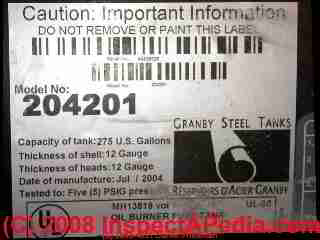 Above Ground Outdoor Home Heating Oil Storage Tanks
Above Ground Outdoor Home Heating Oil Storage Tanks
Oil tank clearance distances, problems, uses, locations
- POST a QUESTION or COMMENT about installing, using, & maintaining an outdoor aboveground heating oil storage tank
Above ground heating oil storage tank - AST inspections outdoors:
How to inspect above ground oil storage tanks (ASTs) when they are installed above ground outdoors.
This article discusses aboveground outdoor oil storage tank installation, clearance distances, codes, standards, and inspection.
We describe the risks of heat loss or leaks when above-ground outdoor oil storage tanks are used outside. This article series aslo explains how water gets into oil storage tanks no matter where they are located, above ground oil tanks, buried oil tanks, or even possibly indoor oil tanks. Photograph at page top courtesy of Arlene Puentes.
InspectAPedia tolerates no conflicts of interest. We have no relationship with advertisers, products, or services discussed at this website.
Codes, Installation, Inspection of Above Ground Oil Storage Tanks Installed Outdoors
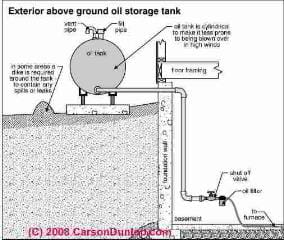 The article also discusses the problems faced by owners of above ground oil storage
tanks located in cold climates. This article is a sub-chapter of OIL TANK INSPECTIONS
The article also discusses the problems faced by owners of above ground oil storage
tanks located in cold climates. This article is a sub-chapter of OIL TANK INSPECTIONS
[Click to enlarge any image]
This article, sketchs, and photographs give advice and example photos for the visual inspection of above ground oil tanks for leaks and damage including damaged or leaky oil storage tanks, improper oil tank piping, valves, and indoor-type oil tanks located outdoors.
Sketch of an above ground outdoor oil storage tank is courtesy of Carson Dunlop Associates, a Toronto home inspection, education & report writing tool company [ carsondunlop.com ].
Article Contents
- ABOVEGROUND OUTDOOR OIL TANK CLEARANCE DISTANCES & LOCATIONS - oil tank clearance distances
- INDOOR RATED OIL TANKS USED OUTDOORS
- HOW WATER GETS INTO OIL TANKS
- PROBLEMS CAUSED BY WATER in OIL TANKS
- ADDITIVES & TREATMENTS for OUTDOOR OIL TANKS
Here are a some important indicators of tank condition that any home inspector can include when an oil storage tank is visible and accessible inside or at a building.
Above Ground Oil Tank Location & Clearance Distances
Question: AST required clearance distance from windows
2017/11/26 Jerry said:
I am installing an outside oil tank. Can I install it between 2 windows. 1 foot from each window?
Reply: AST must be 5 ft. from buildings, vents must be at least 2 ft. from openings.
Jerry,
The short answer is no. You need no less than two feet from a window and you may need to be five feet from the building wall, giving a still greater distance.
For example the 2008 UMC (cited below) states [excerpting]
1305.13.4 Above ground; outside a building. Tanks located above ground, outside of buildings, shall comply with the following requirements:
2. Distances to buildings, lot lines and other tanks.
Storage tanks of a capacity greater than 330 gallons (1250 L) shall be not less than 1 1/4 tank diameters and in no case less than 10 feet (3048 mm) from the tax lot line, the nearest building or adjacent tank.
However, in no case shall the clearance between individual tanks and the tax lot line be less than the distance fixed by the following formula:‡
M.C. = 10 + 4 [ (G-275) / 5000 ] (Equation 13-1)
where: M.C. = Minimum clearance from nearest surface of tank to tax lot line, in feet. G =Capacity of tank, in gallons.
1305.7.2 Termination location.
The location of the normal vent pipe terminations shall comply with the following:
1. Liquid fuel normal vent pipes shall terminate outside of buildings in a nonhazardous location at a point not less than 2 feet (610 mm) measured vertically or horizontally from any building opening and not less than 2 feet (610 mm) nor more than 12 feet (3658 mm) above the fill pipe terminal.
2. If the normal vent pipe terminal is not visible from the fill pipe terminal location, a 1-inch (25 mm) tell-tale line shall be connected to the tank and shall parallel the fill pipe and terminate at the fill pipe terminal with an unthreaded end. Such tell-tale lines shall be provided with a check valve set to prevent flow of surface water to the storage tank.
3. Normal vent pipes shall terminate sufficiently above the ground to avoid being obstructed with snow or ice.
4. Normal vent pipes from tanks containing heaters shall be extended to a location where oil vapors discharging from the normal vent will be readily diffused.
Clearance Distances for Oil Tanks from Building Walls, Foundations, Property Lines
NFPA 30 Table 22.4.1.1(b) Reference Table (NFPA 30 2008) gives the clearance distances for an above ground oil storage tank (AST) to property lines and buildings. A 275 gallon oil tank needs to be 5 ft. or more from any "important building". That specification would include the distance to a window as that's a component of your building.
In addition, the Uniform Mechanical Code, such as adopted by New York City and many other municipalities (2008) specifies that no oil storage tank can be closer than three feet from a building foundation.
US Code-Specified Heating Oil Storage Tank Clearance Distances Required for AST's
NFPA 30 Table 22.4.1.1 (b) Clearance Distances for Aboveground Oil Tanks |
||
| Tank Capacity, Gals | Property Line, Ft. | Important Bldg or Public Way, Ft |
| < 275 | 5 | 5 |
| 275 - 750 | 10 | 5 |
| 751 - 12,000 | 15 | 5 |
Notes to the Table Above
In the same document, NFPA 30 Table 22.4.1.1 (1) gives adjustments to these distances to the property line and to important buildings for tanks of various types
Source: NFPA 30-2008: Basic Requirements for Storage Tanks UL-142 Steel Aboveground Tanks for Flammable & Combustible Liquids [PDF - workbook] New York City Metro ChapterSociety of Fire Protection Engineers New York, NY — February 22, 2011 , retrieved 2017/11/26, original source: http://www.sfpemetrony.org/docs/2011-02-22-nfpa-30-tank-storage-workbook.pdf
UK Heating Oil Storage Tank Clearance Distances Required for AST's
UK Clearance Distances for Aboveground Oil TanksFor oil tanks with a total capacity less than 3,500 litres (925 gal) |
||
| Feature | Distance ft -in |
Distance m - mm |
| Adjacent structure | 6 ft. | 1800 mm |
| Building eaves, not fire-rated | 6 ft. | 1800 mm |
Building opening (window, door) |
6 ft. | 1800 mm |
| Fence (not property boundary) | 2 ft | 600 mm |
| LPG Storage Tanks 1 | 9 ft 11 in | 3 m |
| Oil-boiler/furnace flue | 6 ft | 1800 mm |
| Plants, foliage | 2 ft. | 600 mm |
| Property line (boundary) Not-fire-rated |
2 ft 6 in | 760 mm |
Notes to the Table Above
- This is for heating oil storage tanks up to 3000L storing fuel with a flash point of 65 °C or less (e.g. Kerosene) and is the distance from bulk LPG storage tanks up to 60 tonnes.
- Before installing ANY heating oil storage tank in the UK an expert risk assessment of risk of fire spread from adjacent structure the oil tank must be completed by a qualified professional such as an APHC or OFTEC and the risk assessment must be kept on file.
- OFTEC, Oil Firing Technical Association, Unit 25,
Riduna Park,
Station Road,
Melton,
Woodbridge,
IP12 1QT UK, Web: https://www.oftec.org/ 01473 626 298 (UK)
01 864 5771 (RoI)
OFTEC was formerly the Domestic Oil Burner Equipment Testing Association (DOBETA)
Clearance Distances for Heating Oil Storage Tank Fill & Vent Piping
I have not found an oil storage tank clearance distance citation that specifically addresses windows. I agree with the implication of your question that during oil storage tank filling the venting of heating oil fumes from the tank vent might produce undesirable odors that could enter a building through a nearby window.
- NFPA 31 8.5.2 (2011) requires that oil fill and vent pipes terminate outdoors, if it is intended to be filled by hose from a fuel delivery vehicle.
- Vents for Class I, II, and III liquids, thus including heating oil storage tanks, shall not discharge inside buildings (according to state or provincial fire regulations)
- [For some fuels such as Class I liquids ] Vent outlets must be at least five feet from building openings and property lines (Purdue) ...
Vent pipe outlets for tanks holding Class I liquids shall be distanced from buildings so that vapors will not pose a human health threat, shall be at least 12 feet above the ground, shall be positioned to prevent vapors from accumulating under eaves or other obstructions, and shall be at least 5 feet from building openings. (Purdue, citing OSHA) - [For some fuels] Vents must be located so that vapors are released at a safe point at a height not less than 12 feet above adjacent ground level. Vent outlets shall be located such that flammable vapors are not trapped by eaves or other obstructions.
- [For some fuels] Vents for flammable liquids should be three feet above the roof line or 12 feet above grade.
- See OIL TANK FILL & VENT PIPING INSPECTION CHECKLIST for details
Heating oil is considered a Class II flammable liquid. For more-volatile Class I liquids, more stringent requirements are given for clearance distances from vent piping to building openings.
Codes & Standards for Aboveground Oil Tank & Tank Piping Clearance Distances
- Laughlin, Tim, "North Carolina & International Fire Codes For Storage of Flammable & Combustible Liquids At Bulk Petroleum Storage-Dispensing Facilities" [PDF], PDH Center, 2410 Dakota Lakes Drive, Herndon VA 20171 USA, (2013) Website: www.PDHcenter.com, Tel: 703-478-6833, (2013) retrieved 2017/11/26, original source: https://pdhonline.com/courses/g134/ASTFire_Code.pdf
- Laughlin, Tim, "a href="../oiltanks/FIRE-CODE-REQUIREMENTS-OF-ASTs-Laughlin-2004.pdf">Above-Ground Petroleum Storage Tank Manual & NC Fire Codes With data on NC Gasoline Vapor Recovery & EPA Spill Plan Information" [PDF], The North Carolina Petroleum Marketers Association 7300 Glenwood Avenue Raleigh, North Carolina 27612 919-782-4411 Web site: www.ncpma.org Tim Laughlin, PE Technical Director (2004)
- NFPA 30-2008:
Basic Requirements
for Storage Tanks UL-142 Steel Aboveground Tanks for Flammable & Combustible Liquids [PDF - workbook] New York City Metro Chapter
Society of Fire Protection Engineers New York, NY — February 22, 2011 , retrieved 2017/11/26, original source: http://www.sfpemetrony.org/docs/2011-02-22-nfpa-30-tank-storage-workbook.pdf - NFPA 30-2008: Technical Requirements for Aboveground Storage Tanks (ASTs) Storing Class IIIB Liquids (other than used oil) [PDF], retrieved 2017/11/26, original source: https://cimico.net/wp-content/uploads/2014/09/Fuel_Storage_Tanks_NFPA_Tech_Requirements.pdf
- UMC, Section MC 1301 FUEL-OIL PIPING and STORAGE, Chapter 13 [PDF] as adopted by New York City (2008) New York City Mechanical Code, retrieved 2017/11/26, original source: https://www2.iccsafe.org/states/newyorkcity/Mechanical/PDFs/Chapte 2013_Fuel-Oil Piping and Storage.pdf
- Whitford, Fred, et. al, ABOVEGROUND PETROLEUM TANKS, [PDF] Purdue University Extension, Tel: 1-888-EXT-INFO, Website: www.ces.purdue.edu PPP-73, (2007) retrieved 2017/11/26, original source: https://www.extension.purdue.edu/extmedia/PPP/PPP-73.pdf
Indoor vs Outdoor Use Rating for Above Ground Oil Storage Tanks
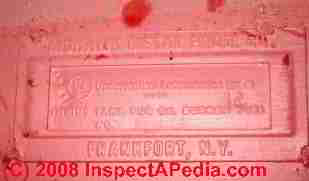
Oil Tank Size and Rating for indoor use but Used Outdoors: If you find a 250g or 275g oil storage tank above ground outside, check its label and UL rating to see if that location was permitted.
Similarly, if you learn that a buried oil tank is an older, small-capacity tank such as 250g or 275g, it is reasonable to assume that an "indoor use only" oil storage tank was buried outside, as we have not located a single instance of a 20 year old 250/275 gallon oil storage tank which was tested, UL-Labeled, and rated for outdoor use above ground nor underground.
An oil tank lacking a rating for outdoor or buried use may lack adequate corrosion resistance and strength, risking rust-through, leaks, and even a dangerous collapse hazard.
See OIL TANK SIZES & VOLUMES for help determining the capacity, size or volume of an oil tank.
See OIL TANK STANDARDS - UL for more about UL labeling & standards for heating oilstorage tanks.Such oil tanks often need to be replaced. Unfortunately so many indoor oil tanks have been used outside, above ground or buried, that their use has been so popular that UL standards for labeling and controlling oil tank use are a bit more confusing.
Modern oil tank labels might no longer indicate if the tank is intended for outdoor use or not, and modern oil tank manufacturers may have rated tanks which were previously labeled "indoors" as now suitable for outdoor use or even buried-use.
Check with the manufacturer of your oil tank before moving it, using it outdoors, or burying it.
Problems Faced by Above Ground Outdoor Oil Storage Tanks
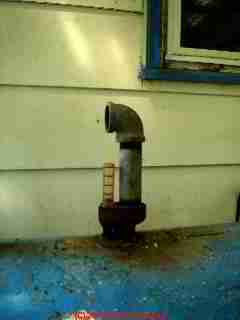 How Water Gets Into Oil Storage Tanks
How Water Gets Into Oil Storage Tanks
Water can enter an oil storage tank by more than one means:
- Water may collect in an oil storage tank, above ground or buried, or in some cases even indoors, when the oil is left at low levels
in the tank for long periods, particularly in periods of cool weather or in periods of alternating warm humid and then cool weather.
As temperatures change around and then in the oil tank, warm moist outside air is drawn into the oil storage tank through its vent. Moisture in the air condenses on the cool tank interior surface, and can accumulate in the tank.
- Water may enter an oil delivery truck by the same means as just discussed above for oil tanks.
From the oil delivery truck water, along with oil, may then be pumped into the property owners oil storage tank. Some oil companies are quite diligent to avoid these problems or to include water filters on their delivery trucks. - Water may enter an oil storage tank by delivery of a "bad" batch of oil from the oil delivery company.
Those huge commercial oil storage depot tanks you may see, perhaps near a railroad line or a river, may be deliberately maintained with a few feet of water in the bottom of the tank so that if a leak occurs it can be discovered as escaping water before the actual oil leaks out.
When an oil company truck is being filled from one of these tanks, in some conditions some of the larger tank's water can enter the oil delivery truck tank where under some circumstances it can also be pumped into the homeowner's oil tank. - Water may enter an outdoor oil storage tank from roof runoff (rain or melting snow) spillage onto or near the oil filler or vent
line for an oil tank.
I've seen this condition both at above ground tanks which were placed under the house eaves (right where roof spillage fell onto the tank) and also at buried tanks whose FILLER PIPE SET FLUSH WITH GROUND [photo]. - Water may enter a buried oil storage tank by groundwater leaks into the oil tank piping, fittings, or via leaks in the upper areas of the tank itself.
Buried oil tanks whose fill or vent pipe are at, below, or close to ground level may also obtain water from surface runoff if the tank fill or vent are not adequately protected.
Problems Caused When Water Enters an Oil Storage Tank?
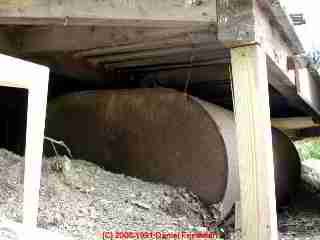
What happens when an oil tank is outdoors? Water can enter the oil storage tank where it causes possibly serious problems for the heating equipment.
Water in the fuel oil or simple exposure of the oil to cold temperatures can lead to loss of heat and resultant damage to a building by several means:The photo shows an oil tank which is half buried outdoors under a deck. Was this tank intended for outdoor use at all? If so, was it intended for use when in contact with the ground? Probably not. The risk is tank rusting, water entry, oil leaks, and related problems we've already listed.
- In cold climates, water in the oil tank, which will reside at the bottom of the tank, may freeze in the tank or in the oil line, particularly for installations at which the oil line is attached to the bottom of the tank.
- In warm, moderate, or cold climates water in the oil storage tank can cause rusting which is pulled into the heating equipment where it clogs the filter, fuel pump, or oil burner nozzle
- In some modern high efficiency systems a special filter is used which will stop flow completely (such as the "System 2000" heating boiler), shutting down the burner in response to water or debris buildup in the filter - a move to protect the equipment.
- In cold climates, heating oil in an outside oil tank supply line may "Jell" and stop flowing at cold temperatures.
- Fire risk: Outside above ground oil storage tanks in cold climates exposed to jelling of the heating fuel may be (in error) fitted with a heating tape in an attempt to avoid freeze-up in the oil line itself. This is a potential fire hazard. Heat tapes should not be used on heating oil lines.
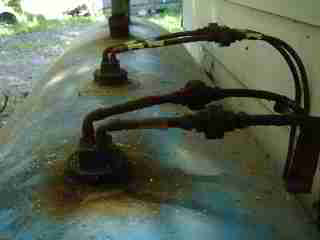
Outdoor oil tanks in cold climates risk loss of heat from freezing water or jelling fuel as we just cited. In the photo shown here the oil lines are taken off of the top of the oil tank so as to avoid picking up water that may be present in the tank, avoiding the icing problem.
Note that no heat tapes are in use on the oil lines (good, that reduces a fire risk). It looks as if there has been some seepage around these oil lines, that the tank is old, and that one tank is being used to serve two oil-fired devices (two sets of oil lines leaving the tank).
Water in oil tanks also often leads to internal corrosion and leaks in the tank itself, regardless of the tank location, though buried tanks and indoor oil tanks are less prone to water accumulation due to in-tank condensation in response to temperature changes than a tank located above ground outside.
Oil storage tanks usually fail from rust perforation due to combination of water inside the tank with sulphur in the fuel oil. External rust, unless very heavy, isn't highly correlated with internal rust. A new tank, when required, may cost more $2000. installed, including removal of the old oil tank.
When an outdoor tank is exposed to these conditions and even for an indoor tank which we suspect has had a dose of water and sludge, we recommend regular use of a fuel oil additive such as 4 in 1 Hot(TM) to absorb water and to help break up sludge.
The best solution is to locate the tank indoors or to build a heated shelter over the outdoor tank.
Heating or Fuel Oil Additives for Outdoor Oil Tanks
In cold climates, heating or fuel oil additives for above-ground outdoor oil tanks can help prevent loss of heat by adding a pour point depressant which lowers the temperature at which the heating oil will form waxes or jell, and by adding a chemical, typically an alcohol, to remove [small amounts] of water from the oil.
I've used a product called "4-in-One Hot" which contains both a sludge break-up chemical and alcohol to help remove water from the heating oil. Such additives may indeed help break up sludge which tends to clog old heating oil lines.
See HEATING OIL CLOUD WAX GEL POINT for details about heating oil waxing or jelling
Watch out: two warnings about using heating oil additives and chemicals for outdoor oil tanks:
- No oil additive is going to remove a large quantity of water
from an oil tank. Measure the amount of water present. If it's inches, your oil company can pump the water out (leaving the heating oil intact). - Oil additives that break up sludge
might in some circumstances precipitate frequent clogging of the oil filter installed at your heating boiler or furnace since an increased amount of debris is being freed and sent along the oil lines.
If you find that your boiler stops working shortly after receiving an oil delivery, check to see if the problem was a clogged oil filter. That would suggest that your tank has a lot of debris and that the debris or sludge were being stirred up whenever oil was delivered. Discuss this concern with your heating service contractor.
Pour point depressants for heating oil tanks are about the same as similar products used by owners of diesel fuel powered automobiles and trucks in cold climates, but except in dire emergency I would not recommend substituting one for the other as there are some differences in these fuels and chemicals.
Note: these tips are not a complete oil tank installation guide. Proper installation must be done by trained service technicians and must comply with local building codes.
Readers whose heating system uses an above-ground outdoor oil storage tank should be sure to also
read HEATING OIL CLOUD WAX GEL POINT
and OIL TANK SLUDGE.
Details about the various types of oil storage tank additives, treatments & chemicals and some warnings about their use are
at OIL TANK TREATMENTS, ADDITIVES.
Reader Comments, Questions & Answers About The Article Above
Below you will find questions and answers previously posted on this page at its page bottom reader comment box.
Reader Q&A - also see RECOMMENDED ARTICLES & FAQs
On 2020-08-1 - by (mod) -
Kim
I'm doubtful but it's possible. If the serial number can track to the vendor who sold that specific tank and if the vendor is able (unlikely) and willing (doubtful) to say to whom they sold the tank decades ago, then it's possible. I'm more doubtful that this is a useful line of inquiry.
Unfortunately when buying a home, the risks are so profound that there is a well-recognized requirement that the buyer perform their very own due-diligence inspections and tests prior to purchase. Your lawyer will tell you to go past that responsibility you'd have to be able to prove a fraud charge.
On 2020-08-18 by Kim Ennis
We have found an abandoned oil tank on our property (that leaked). There is a serial number on the metal inspection tag on the tank with a UL Cda No. Can do a lookup to find the owner of the tank using serial no? Thanks Kim
On 2017-11-20 - by (mod) -
John
On outdoor exposed iron pipe threads you can remove rust using a wire brush. However if piping is badly rusted or corroded it may be beyond repair and use. Use the page top or bottom CONTACT link to send me a photo and I'll comment further.
On 2017-11-20 by johnmc46
can the rust be removed from the threads
On 2017-03-17 - by (mod) -
You do or will have a problem when sludge and crud from the oil tank fouls the oil burner nozzle and you lose heat.
Removing the outside filter reduces freeze risk by removing what is often a water catch point.
But you need an oil filter - have one installed inside at the oil burner.
On 2017-03-17 by craig
My home heat provider recently serviced my outside oil tank and removed the filter to eliminate freezing. He didn't replace the filter. Do I have a problem?
On 2016-04-04 - by (mod) -
Frank there is both fiberglass wrap insulation and thicker snap-around foam insulation for pipes (which I prefer), sold very widely at hardware stores, plumbing suppliers, building suppliers such as Home Depot or Lowes - but for insulation for small-diameter pipes, some of those suppliers may let you down.
In that case look for air conditioner & heat pump refrigeration tubing pipe insulation - as those are in the same diameter range. Same supply sources.
Watch out: there are some added concerns to keep in mind for outdoor oil tanks, and just insulating the oil line probably won't be enough (unless you live in a rather warm climate)
See https://inspectapedia.com/heat/Heating_Oil_Waxing.php on oil line waxing
and
See https://inspectapedia.com/oiltanks/Oil_Tank_Treatments.php on adding pour point depressant chemicals (or a kerosene mix) to prevent waxing
and
See https://inspectapedia.com/oiltanks/Oil_Piping_Heat_Tapes.php about reasons to avoid using a heat tape on oil lines
On 2016-04-04 by Frank
where can I get 3/8ths insulation , for outside pipes
...
Continue reading at OIL TANK FILL & VENT PIPING INSPECTION CHECKLIST or select a topic from the closely-related articles below, or see the complete ARTICLE INDEX.
Or see these
Recommended Articles
- BOILER CLEARANCE DISTANCES
- FURNACE CLEARANCE DISTANCES
- HEAT TAPES on OIL TANK PIPING
- OIL STORAGE TANKS - home
- OIL TANK ABOVE GROUND (AST) GUIDE
- ABANDONED INDOOR OIL TANK
- ABOVE GROUND OUTDOOR OIL TANKS
- AST CLEARANCE DISTANCES & LOCATIONS
- OIL TANK FILL & VENT PIPING INSPECTION CHECKLIST
- OIL TANK FILL & VENT PIPE CLEARANCE DISTANCES
- OIL TANK ABOVEGROUND INDOOR - CLEARANCE DISTANCES - above ground indoor oil tank clearance distances
- OIL TANK ABOVEGROUND OUTDOOR - CLEARANCE DISTANCES & LOCATIONS - above ground outdoor oil tank clearance distances
- OIL TANK INSPECTION & TROUBLESHOOTING - clearance distances to above ground oil storage tanks & buried oil tanks
- OIL TANK INSTALLATION, CLEARANCES, PIPING, PROTECTION REGULATIONS
- OIL TANK HISTORY REVIEW
- SPHERICAL OIL STORAGE TANKS - the HORTON SPHERE
- OIL TANK SUPPORT
- OIL TANK CODES & STANDARDS - home
Suggested citation for this web page
ABOVE GROUND OUTDOOR OIL TANKS at InspectApedia.com - online encyclopedia of building & environmental inspection, testing, diagnosis, repair, & problem prevention advice.
Or see this
INDEX to RELATED ARTICLES: ARTICLE INDEX to HEATING OIL, OIL BURNERS, OIL FIRED HEATERS, OIL TANKS
Or use the SEARCH BOX found below to Ask a Question or Search InspectApedia
Ask a Question or Search InspectApedia
Try the search box just below, or if you prefer, post a question or comment in the Comments box below and we will respond promptly.
Search the InspectApedia website
Note: appearance of your Comment below may be delayed: if your comment contains an image, photograph, web link, or text that looks to the software as if it might be a web link, your posting will appear after it has been approved by a moderator. Apologies for the delay.
Only one image can be added per comment but you can post as many comments, and therefore images, as you like.
You will not receive a notification when a response to your question has been posted.
Please bookmark this page to make it easy for you to check back for our response.
Our Comment Box is provided by Countable Web Productions countable.ca
Citations & References
In addition to any citations in the article above, a full list is available on request.
- "How do you choose the right tank testing method?", Cynthia Johnson, Fuel Oil & Oil Heat Magazine, November 1995
- National Association of Oil Heat Service Managers, PO Box 380, Elmwood Park, NJ 07407
- "Homeowners Guide to Fuel Storage," Agway Energy Products, Verbank, NY, November 1990
- In addition to citations & references found in this article, see the research citations given at the end of the related articles found at our suggested
CONTINUE READING or RECOMMENDED ARTICLES.
- Carson, Dunlop & Associates Ltd., 120 Carlton Street Suite 407, Toronto ON M5A 4K2. Tel: (416) 964-9415 1-800-268-7070 Email: info@carsondunlop.com. Alan Carson is a past president of ASHI, the American Society of Home Inspectors.
Thanks to Alan Carson and Bob Dunlop, for permission for InspectAPedia to use text excerpts from The HOME REFERENCE BOOK - the Encyclopedia of Homes and to use illustrations from The ILLUSTRATED HOME .
Carson Dunlop Associates provides extensive home inspection education and report writing material. In gratitude we provide links to tsome Carson Dunlop Associates products and services.


